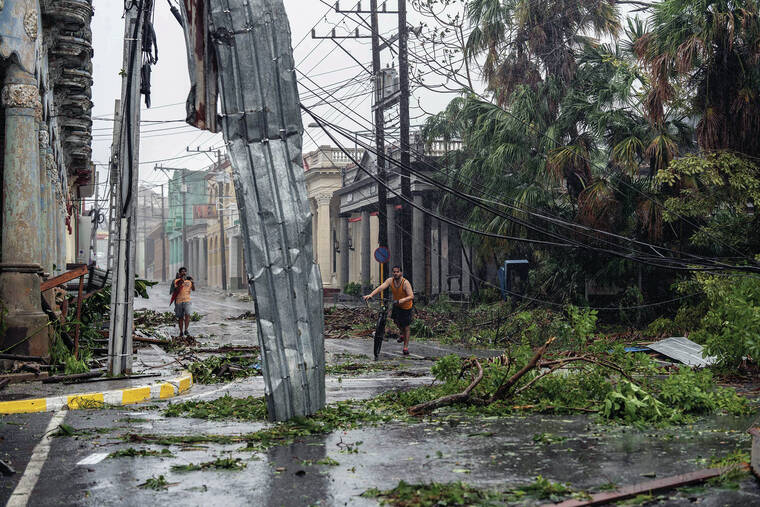Hurricane Ian strikes Cuba, Florida braces for winds, floods
HAVANA — Hurricane Ian tore into western Cuba as a major hurricane Tuesday, knocking out power to the entire country and leaving 11 million people without electricity, before churning on a collision course with Florida over warm Gulf waters amid expectations it would strengthen into a catastrophic Category 4 storm.
Ian made landfall in Cuba’s Pinar del Rio province, where officials set up 55 shelters, evacuated 50,000 people, and took steps to protect crops in the nation’s main tobacco-growing region. The U.S. National Hurricane Center said Cuba suffered “significant wind and storm surge impacts” when the hurricane struck with top sustained winds of 125 mph (205 kmh).
ADVERTISING
Ian was expected to get even stronger over the warm Gulf of Mexico, reaching top winds of 130 mph (209 kph) approaching the southwest coast of Florida, where 2.5 million people were ordered to evacuate.
Tropical storm-force winds were expected across the southern peninsula late Tuesday, reaching hurricane-force Wednesday — when the eye was predicted to make landfall. With tropical storm-force winds extending 140 miles (225 kilometers) from Ian’s center, damage was expected across a wide area of Florida.
It was not yet clear precisely where Ian would crash ashore. Its exact track could determine how severe the storm surge is for Tampa Bay, said University of Miami hurricane researcher Brian McNoldy. Landfall south of the bay could make the impact “much less bad,” McNoldy said.
Gil Gonzalez boarded up his windows Tuesday and had sandbags ready to protect his Tampa home. He and his wife had stocked up on bottled water and packed flashlights, battery packs for their cellphones and a camp stove before evacuating.
“All the prized possessions, we’ve put them upstairs in a friend’s house and nearby, and we’ve got the car loaded,” Gonzalez said on his way out.
Florida Gov. Ron DeSantis urged people to prepare for extended power outages, and to get out of the storm’s potential path.
“It is a big storm, it is going to kick up a lot of water as it comes in,” DeSantis told a news conference in Sarasota, a coastal city of 57,000 that could be hit. “And you’re going to end up with really significant storm surge and you’re going to end up with really significant flood events. And this is the kind of storm surge that is life threatening.”
He said about 30,000 utility workers have already been positioned around the state but it might take days before they can safely reach some of the downed power lines.
“This thing’s the real deal,” DeSantis said. “It is a major, major storm.”
DeSantis said nearly 100 shelters had been opened by Tuesday afternoon, with more expected. He said most buildings in Florida are strong enough to withstand wind, but the 2.5 million people who have been told to evacuate face the greatest danger from flooding.
Hundreds of residents were being evacuated from several nursing homes in the Tampa area, where hospitals were also moving some patients.


